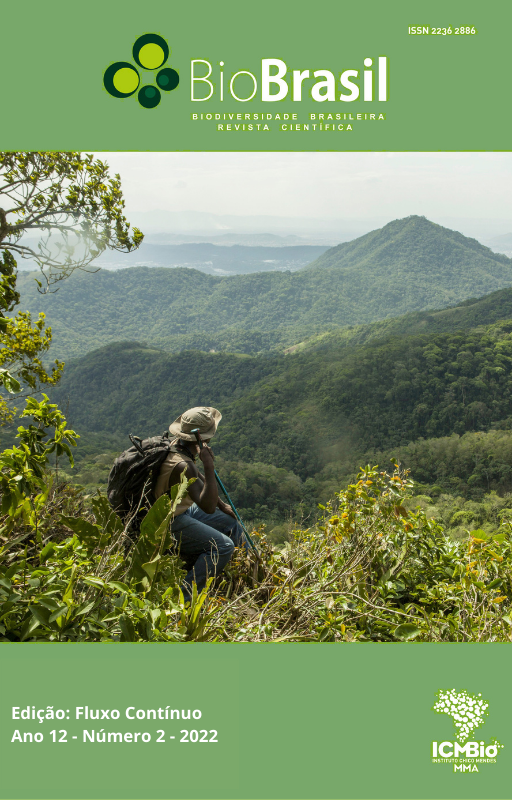Participatory Methodologies for the Elaboration of the Fishing Diagnosis in the APA Costa dos Corais
DOI:
https://doi.org/10.37002/biodiversidadebrasileira.v12i2.2177Keywords:
Community, management, co-management, fishing activity, protected areaAbstract
In order to identify the main problems, conflicts, and potentialities of the fishing territory of the Área de Proteção Ambiental (APA) Costa dos Corais, the Management Council of the Marine Protected Area has developed a participatory project with the fishermen working in the APA to carry out a diagnosis of fishing, a fundamental component for fisheries management. The aim of the present experience report is to disseminate the methodological proposal used in the construction of the participative diagnosis of the artisanal fisheries, applied in the APA Costa dos Corais. The project was executed under the strategy of using circles of support and efficient communication in seven main stages: 1) training; 2) data collection; 3) mobilization; 4) sectorial meetings; 5) use of participative tools; 6) feedbacks; 7) formation of the fishermen and fisherwomen network. A total of 30 young people from the fishing community, indicated by their leaderships, were trained to support the interviews; they applied 1.439 interviews in 11 municipalities of the APA Costa dos Corais. The process of execution of the fishing diagnosis also worked as recruitment of new leaderships and promoted the increase of the participation in the dialogue spaces. More than 70 fishermen and fisherwomen of the region were included in the local fishery articulation network. The Managing Council of the APA Costa dos Corais reaps the fruits of participative planning that strengthens the relationship between management and the fishing community. It is explicit that using more and more participative methods, accessible language and the employment of technological innovation facilitate the dialogue, encourage greater participation, and qualify the results.Â
References
Biernacki P, Waldorf D. Snowball Sampling: Problems and techniques of Chain Referral Sampling. Sociological Methods & Research, 10(2): 141-163, 1981.
Chambers R. 1992. Rural appraisal: rapid, relaxed and participatory. London: Institute of Development Studies. 68p.
Diegues ACS. 1995. Povos e mares: Leituras em socioantropologia marítima. NUPAUB-USP. 269p.
Freire KMF, Pauly D. Fisheries catch reconstructions for Brazil's mainland and oceanic islands. Fisheries Centre Research Reports, 23(4): 3-30, 2015.
Grein PPB, Amaral MA. Teoria Crítica da Tecnologia e Design Participativo na Construção de um Repositório de Recursos Educacionais Abertos. Tecnologias, sociedade e conhecimento, 3(1): 79-99, 2015.
ICMBio (Instituto Chico Mendes de Conservação da Biodiversidade). Plano de Manejo da Área de Proteção Ambiental Costa dos Corais. 2021. Tamandaré/PE, 80p.
Ladle RJ, et al. Conservation culturomics. Front. Ecol. Environ, 14: 269-275, 2016.
Lapolli M. Infografia além da objetividade. Revista Brasileira de Design da Informação, 13(2): 309-320, 2016.
Lima GA, Catelão EM. Infográfico: produção e possibilidades no uso educacional do ensino de Geografia. Ens. Tecnol. R., 3(1): 1-20, 2019.
Loureiro CFB, Azaziel M, Franca N. 2003. Educação ambiental e gestão participativa em Unidades de Conservação. 44p.
Loureiro CFB, Cunha CC. Educação ambiental e gestão participativa de unidades de conservação: Elementos para se pensar a sustentabilidade democrática. Ambient. e Soc. 11: 237-253, 2008.
Mattos SMG, Wojciechowski MJ, Gandini FC. 2020. Iluminando as Capturas Ocultas da Pesca Artesanal Costeira no Brasil: um estudo de caso. Illuminating Hidden Harvests (IHH) Project, organized and coordinated by the Food and Agriculture Organization of the United Nations (FAO), the WorldFish, and the University of Duke. Instituto Maramar para a Gestão Responsável dos Ambientes Costeiros e Marinhos (Maramar Institute for Coastal Management). (BR). Relatório Executivo. 71p.
Minayo MCS, Deslandes SF, NEeto OC, Gomes R. 2002. Pesquisa Social: teoria, método e criatividade. 21º ed. Vozes. 80p.
MMA (Ministério do Meio Ambiente). Cadastro das Unidades de Conservação - CNUC. 2020. Disponível em:< https://app.powerbi.com/view?r=eyJrIjoiMjUxMTU0NWMtODkyNC00NzNiLWJiNTQtNGI3NTI2NjliZDkzIiwidCI6IjM5NTdhMzY3LTZkMzgtNGMxZi1hNGJhLTMzZThmM2M1NTBlNyJ9 > Acesso em: 02 de out. de 2020.MAPA. Ministério da Agricultura, Pecuária e Abastecimento. <http://www.agricultura.gov.br/assuntos/aquicultura-e-pesca/registro-monitoramento-da-aquicultura-e-da-pesca>. Acesso em 09/08/2020.
Nunes ACO. 2018. Diálogos e práticas restaurativas nas escolas: guia prático para educadores. Ministério Público do Estado de São Paulo e Secretaria de Educação do Município de São Paulo. 145p.
Poffenberger M, Mcgean B, Ravindranath NH, Gadgil, M. 1992. Diagnostic tools for supporting joint forest management systems. Society for Promotion of Wasteland Development New Delhi - SPWD. 102p.
Robbins P. Beyond ground truth: GIS and the environmental knowledge of herders, Professional foresters, and other traditional communities. Human Ecology, 31(2): 233-253, 2003.
Seixas CS. 2005. Abordagens e técnicas de pesquisa participativa em gestão de recursos naturais, p. 76-105. In: Vieira PF, Berkes F, Seixas CS (orgs). Gestão integrada e participativa de recursos naturais. Conceitos, métodos e experiências. 415p.
Souza CN. 2017. A governança na implantação de zoneamentos em áreas de proteção ambiental marinhas. Dissertação (Mestrado em Desenvolvimento e Meio Ambiente). Universidade Federal de Pernambuco. 152p.
Steiner AQ, Eloy CC, Amaral JRBC, Amaral FMD, Sassi R. O turismo em áreas de recifes de coral: considerações acerca da Área de Proteção Ambiental Costa dos Corais (Estados de Pernambuco e Alagoas). OLAM-Ciência e Tecnologia, 6(2): 281-296, 2006.
Downloads
Published
Issue
Section
License
Copyright (c) 2022 Biodiversidade Brasileira - BioBrasil

This work is licensed under a Creative Commons Attribution-NonCommercial-NoDerivatives 4.0 International License.
Os artigos estão licenciados sob uma licença Creative Commons Atribuição-NãoComercial-SemDerivações 4.0 Internacional (CC BY-NC-ND 4.0). O acesso é livre e gratuito para download e leitura, ou seja, é permitido copiar e redistribuir o material em qualquer mídia ou formato.











